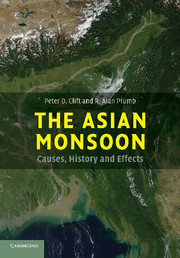Book contents
- Frontmatter
- Contents
- Preface
- Acknowledgements
- 1 The meteorology of monsoons
- 2 Controls on the Asian monsoon over tectonic timescales
- 3 Monsoon evolution on tectonic timescales
- 4 Monsoon evolution on orbital timescales
- 5 Erosional impact of the Asian monsoon
- 6 The Late Holocene monsoon and human society
- References
- Further reading
- Index
- Plate section
5 - Erosional impact of the Asian monsoon
Published online by Cambridge University Press: 01 September 2009
- Frontmatter
- Contents
- Preface
- Acknowledgements
- 1 The meteorology of monsoons
- 2 Controls on the Asian monsoon over tectonic timescales
- 3 Monsoon evolution on tectonic timescales
- 4 Monsoon evolution on orbital timescales
- 5 Erosional impact of the Asian monsoon
- 6 The Late Holocene monsoon and human society
- References
- Further reading
- Index
- Plate section
Summary
The changing strength of the Asian monsoon described in preceding chapters has had a major effect on the continental climate of Asia, and the oceanography of the surrounding seas. The monsoon is partially controlled over time spans >1 My by the tectonic evolution of the solid Earth. However, in turn, the monsoon has had an influence on the geology and tectonics across South and East Asia. This is for the simple reason that climate, and especially rainfall, is a major factor controlling the erosion of the continental crust, and this in turn affects how mountain belts are exhumed and uplifted. Because of the huge area of the monsoon-affected regions and the dominance of the Himalayas and Tibet in the global topography, continental erosion driven by the monsoon can have far-reaching consequences, not only for the region, but also for the global ocean through run-off via some of the world's largest rivers. In this chapter we examine the evolving erosion of Asia in the context of the monsoon and assess how the monsoon may have controlled the tectonics of the Asian mountain ranges.
Monsoon and oceanic strontium
The potentially global importance of monsoon-driven erosion has been recognized for some time now via the evolving Sr isotope character of the oceans (Figure 5.1; Rea 1992). The isotope character of sea water shows a steady, coherent evolution to more radiogenic values since the Eocene (∼40 Ma).
- Type
- Chapter
- Information
- The Asian MonsoonCauses, History and Effects, pp. 159 - 196Publisher: Cambridge University PressPrint publication year: 2008



